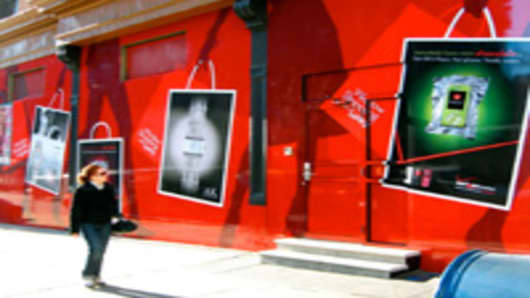Empty storefronts can deter shoppers but there are some very creative solutions coming out to plug these gaping holes in the retail landscape.
Rows of stores “look like teeth,” said Steve Birnhak, CEO of Inwindow Outdoor , which puts ads in vacant storefront windows. “When one goes out of business, it’s like the street lost a tooth!” he said.
And that can lead to urban decay, Birnhak said. People start littering in front of the store. It doesn’t get picked up. The windows get graffitied. Next thing you know, people are crossing the street to avoid the empty storefront and it hurts surrounding businesses.
“It’s a downward spiral,” he said.
As a result, some landlords have started renting out the vacant windows for advertising or art displays. It serves two purposes: It brings in some revenue in the short term until a new business moves in and it helps keep the block from looking like it's going downhill.
Birnhak started his business in 2002 after he noticed a GI Joe display in a window on 23 rdStreet in Manhattan, when there wasn't a store there. (Turns out, a lot of toy companies have offices in that building.) A lightbulb went off in his head and he realized vacant store windows could be a great place for marketing.
Since the recession started and the pace of store closings has escalated, Birnhak has seen his revenue soar.
He places storefront ads for clients including Intel, Target , Disney, JPMorgan Chase, Sony, JetBlue and Sprint.
They’re even doing some high-tech ads in vacant storefront windows that involve hologram, touch-screen and Bluetooth technologies.
Birnhak said his clients love it because the ads are huge and at eye level. You just couldn’t do interactive technology like this on a big billboard so high above the target audience.
Plus, the communities appreciate it because it stems urban decay at the source.
Of course, there are some cities opposed to such ads and activists who are campaigning against what they call “illegal” ads.
Birnhak said his company is working with these groups that oppose the ads.
“What’s the alternative?” Birnhak said. “You’ve got an empty, dead space, maybe it has a ladder, hanging brown paper — we cover that up,” he explained.
Meanwhile, in New Rochelle, NY, the town is getting ready to pass a law that is precisely the opposite: It wants to require landlords to cover up such empty storefronts with artwork or something more pleasing to the eye than a vacant window, the Journal News reports.
“Obviously it's always preferable to have all storefronts filled with active and successful businesses," Mayor Noam Bramson is quoted as saying. "But we recognize in a difficult economy and in a general transitional period for our downtown we should make provisions for improving the appearance of vacant storefronts."
And in New Haven, Conn., Yale students are using empty storefronts to display their sculptures .
It may just be art and advertising that save small towns and big cities, alike, from the grip of the recession.
How do you like them apples, tough guy?
You may now apologize for all the times you used the phrase: “Arty farty.”
More From CNBC.com:
- Time to Put the Fun in 'FUNemployed!'
- Recession Lesson From a Caveman
- How to Get a $3 Million Mansion for $10
- Can You Afford to 'Win' a $3 Million Mansion?
- Happy Hour: The New Day Job
- Out of Work? Why Not Be in a Movie?
- The 86 Biggest Lies onWall Street
- Stressed Consumer? Digital Coupon Use Soars
- Steak, Beer, Rent: The Most & Least Expensive Cities
- The Most Recession-Resistant Cities
Questions? Comments? Write toponyblog@cnbc.com .



